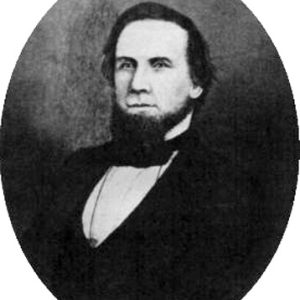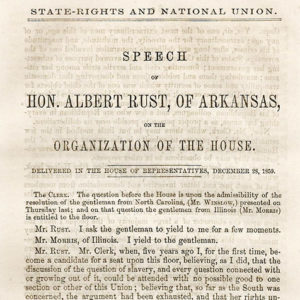calsfoundation@cals.org
Albert Rust (1818–1870)
Albert Rust—Confederate general, congressman, legislator, and lawyer—helped shape the course of Arkansas in the early years of its statehood. Rust served as an important figure in helping to build the communities of Union County.
Rust was born in 1818 in Fauquier County, Virginia, near the Maryland border. His exact birth date is uncertain. In 1837, he made the trek from Virginia to Arkansas, settling on the banks of the Ouachita River in Union County. Soon after his arrival, he bought a few acres of land and a store house near the river. In 1838, he became a county surveyor, helping organize the untamed land into defined sections for sale.
In 1839, the county seat was moved to Scarborough’s Landing (called Champagnolle after 1839). Since Rust had the only building that would suffice for a courthouse, county officials decided that his storehouse would be used as the official courthouse. Rust began studying law and was admitted to the bar around this time. In 1842, Rust won the first of three terms to the state House of Representatives, and soon moved his law practice to El Dorado (Union County). After the United States Land Office opened in Champagnolle in 1845, Rust became the receiver, processing and validating land claims in the area.
Rust married Jane Carrington, daughter of a wealthy Virginia gentleman, on April 17, 1844, in Hempstead County.
In 1846, Rust ran in a special election for an open congressional seat as one of four Democrats against one Whig candidate. Rust won fourteen counties, but his spirited effort earned him only a third place finish in the statewide contest.
In 1852, Rust dusted off his political ambitions once again and won a fourth term representing Union County in the state legislature. His fellow representatives honored him by electing him speaker pro-tempore for the session, the second-highest position in the state House of Representatives.
In 1854, southern Arkansas Democrats unanimously nominated Rust for Congress. In the general election, he captured sixty-seven percent of the vote. He clashed with the other congressmen repeatedly over sectional issues, forcing one to apologize to him on the floor of the House of Representatives. He took little part in the debates, though he showed an interest in military affairs, particularly frontier defense. Rust’s lackluster term failed to impress the voters. Democrats refused to renominate him for a second term in 1856, nominating Edward A. Warren instead. Nevertheless, Rust rallied to repair his political fortunes, and the Democrats embraced him at their 1858 convention. He cruised to an easy victory, capturing seventy percent of the vote. Throughout his second term, Rust continued his interest in military affairs, worked for improvements for Red River barge traffic, and continued his combativeness with other congressmen.
In May 1861, Arkansas seceded from the Union. Rust had been a vocal supporter of secession. Upon Arkansas’s decision to secede, Rust and four other Arkansans were named to represent the state in the Provisional Confederate House of Representatives. Rust served on the Postal Affairs Committee. After elections were held for the Confederate Congress in late 1861, Rust stepped down from his position.
Rust had served in the state militia for years, rising to the rank of colonel. As war erupted, he organized the Arkansas Third Infantry. His first combat assignment was at the Battle of Cheat Mountain in what is now West Virginia in mid-September 1861. In 1862, Rust received promotion to brigadier general. Rust participated in the Battle of Cotton Plant, also known as Hill’s Plantation, in 1862. He later saw action in Tennessee and Mississippi in 1862 and 1863 and served the remainder of the war in Louisiana.
In the difficult post-war period, he returned to Arkansas to resume his law practice. On April 4, 1870, the former congressman and general died near Little Rock (Pulaski County). His obituary in the Arkansas Gazette relates that his funeral was held in Little Rock. His burial plot location is in dispute, but a stone honoring him stands in Oakland-Fraternal Cemetery and sexton’s records suggest he may have been buried there on April 6. The Biographical Directory of the United States Congress lists information that conflicts with these facts, such as a death date of April 3 and his death and burial in El Dorado.
Bolton, S. Charles. Arkansas, 1800-1860: Remote and Restless. Fayetteville: University of Arkansas Press, 1998.
“Congressional Globe.” http://memory.loc.gov/ammem/amlaw/lwcg.html (accessed March 11, 2021).
Cordell, Anna H. “Champagnolle: A Pioneer River Town.” Arkansas Historical Quarterly 10 (Spring 1951): 37–45.
DeBlack, Thomas A. With Fire and Sword: Arkansas, 1861–1874. Fayetteville: University of Arkansas Press, 2003.
Priest, Sharon. Historical Report, Arkansas Secretary of State, 1998. Little Rock: State of Arkansas, 1998.
“Rust, Albert.” Biographical Directory of the United States Congress. http://bioguide.congress.gov/scripts//biodisplay.pl?index=R000544 (accessed March 11, 2021).
Rust Family Collection, 1844–1913. Center for Arkansas History and Culture. University of Arkansas at Little Rock, Little Rock, Arkansas.
Kenneth Bridges
South Arkansas Community College
 Law
Law Louisiana Purchase through Early Statehood, 1803 through 1860
Louisiana Purchase through Early Statehood, 1803 through 1860 Politics and Government
Politics and Government Albert Rust
Albert Rust  Albert Rust Speech
Albert Rust Speech 




Comments
No comments on this entry yet.